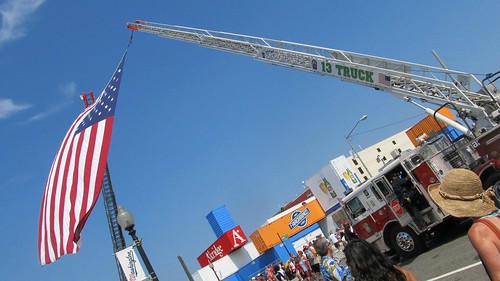On 1 May 1865, newly freed African-American slaves buried and honored 257 Union soldiers, during a special ceremony in Charleston, South Carolina. Was this the first 'Memorial Day' to be observed in the U.S.?
The "First Decoration Day," as this event came to be recognized in some circles in the North, involved an estimated ten thousand people, most of them black former slaves. During April, twenty-eight black men from one of the local churches built a suitable enclosure for the burial ground at [at a racetrack turned war prison called] the Race Course. In some ten days, they constructed a fence ten feet high, enclosing the burial ground, and landscaped the graves into neat rows. The wooden fence was whitewashed and an archway was built over the gate to the enclosure. On the arch, painted in black letters, the workmen inscribed "Martyrs of the Race Course."
At nine o'clock in the morning on May 1, the procession to this special cemetery began as three thousand black schoolchildren (newly enrolled in freedmen's schools) marched around the Race Course, each with an armload of roses and singing "John Brown's Body." The children were followed by three hundred black women representing the Patriotic Association, a group organized to distribute clothing and other goods among the freedpeople. The women carried baskets of flowers, wreaths, and crosses to the burial ground. The Mutual Aid Society, a benevolent association of black men, next marched in cadence around the track and into the cemetery, followed by large crowds of white and black citizens.
All dropped their spring blossoms on the graves in a scene recorded by a newspaper correspondent: "when all had left, the holy mounds — the tops, the sides, and the spaces between them — were one mass of flowers, not a speck of earth could be seen; and as the breeze wafted the sweet perfumes from them, outside and beyond ... there were few eyes among those who knew the meaning of the ceremony that were not dim with tears of joy." While the adults marched around the graves, the children were gathered in a nearby grove, where they sang "America," "We'll Rally Around the Flag," and "The Star-Spangled Banner."
The official dedication ceremony was conducted by the ministers of all the black churches in Charleston. With prayer, the reading of biblical passages, and the singing of spirituals, black Charlestonians gave birth to an American tradition. In so doing, they declared the meaning of the war in the most public way possible — by their labor, their words, their songs, and their solemn parade of roses, lilacs, and marching feet on the old planters' Race Course.
After the dedication, the crowds gathered at the Race Course grandstand to hear some thirty speeches by Union officers, local black ministers, and abolitionist missionaries. Picnics ensued around the grounds, and in the afternoon, a full brigade of Union infantry, including Colored Troops, marched in double column around the martyrs' graves and held a drill on the infield of the Race Course. The war was over, and Memorial Day had been founded by African Americans in a ritual of remembrance and consecration.
—David W. Blight: Race and Reunion: The Civil War in American Memory
-----more-----
I've reprinted the above passage of Professor Blight's book as quoted at Snopes.com, which added this 'fact-checker' conclusion:
"Although contemporaneous accounts from the Charleston Daily Courier describe and document the 1865 ceremony that took place there, and the event was one the earliest known observances similar to what we would now recognize as Memorial Day, whether it was truly the first such ceremony, and what influence (if any) it might have had on later observances, are still matters of contention. Professor Blight termed it "the first Memorial Day" because it predated most of the other contenders, but he noted he has no evidence that it led to General Logan’s call for a national holiday in 1868: "I'm much more interested in the meaning that’s being conveyed in that incredible ritual than who's first," he said."










No comments:
Post a Comment
Comment here ...